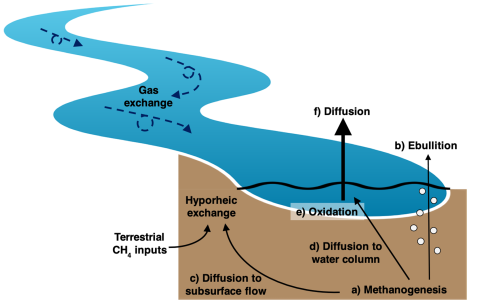This research was published in the INSPIRED: A Publication of the New Hampshire Agricultural Experiment Station (Spring 2024)
Researchers: A. K. Robison, W. M. Wollheim, C. Perryman, A. Cotter, J. MacKay, R. Varner, P. Clarizia & J. Ernakovich
With 280 square miles of freshwater lakes and ponds and over 19,000 miles of rivers and streams in New Hampshire, water is critical to the health, economy, and recreation of Granite Staters. However, with aquatic ecosystems annually releasing a similar amount of methane that humans release to the atmosphere each year, New Hampshire water may be playing a bigger role in greenhouse dynamics than previously thought. And while streams have been seen more as pipelines for moving methane rather than contributors, their roles in being a source or suppressor of methane is not well measured.
Background and Key Concepts
Aquatic bodies play different roles in the release of methane gas. Wetlands, lakes, and reservoirs all release methane directly into the atmosphere, primarily through a process known as ebullition. In this process, methane literally bubbles out of the wetland and enters the atmosphere, contributing to the greenhouse gas effect. Rivers and streams haven’t historically been viewed as nearly as important to the global methane cycle. Instead, they’ve been regarded as pipelines for moving material between bodies of water. This research focuses on identifying streams’ precise role in the greenhouse gas emission process.

Fig. 1. Locations of four study stream reaches in southeast New Hampshire and northeast Massachusetts.
Methodology
The research measured methane emissions and soil microbial communities within four streams in New Hampshire and Massachusetts (Fig. 1). These streams were chosen to represent contrasting land-use conditions, including developed (suburban) and forested watersheds. The selected streams have been previously studied for nutrient and carbon cycling and land-use impacts. Two streams, Sawmill Brook and College Brook, are in relatively developed suburban landscapes, while the other two, Cart Creek and Dube Brook, are predominantly in forest-covered landscapes.
Samples were collected from the four streams approximately each week, then analyzed at the Trace Gas Biogeochemistry Lab at the UNH Earth Systems Research Center. Statistical analyses were performed to assess differences in methane concentration, flux, isotopic composition, and microbial communities between streams and sampling depths. The microbial communities in the streambeds were analyzed at the UNH Hubbard Center for Genome Studies to identify the presence of the types of bacteria that create methane (called methanogens) and oxidize methane to carbon dioxide (called methanotrophs).
Results and Impacts
Key Findings
- Small streams were found to emit methane at rates comparable to lakes and wetlands, demonstrating that previous estimates of their contribution to methane emissions were likely undervalued.
- Unlike lakes and wetlands where methane is primarily emitted through ebullition, methane emissions in streams predominantly occur through diffusion, where methane dissolved in the water is released from the water’s surface into the atmosphere.
- The presence of methane-producing and methane-consuming bacteria indicates active methane production and oxidation within stream ecosystems.
About the Co-author

Wilfred Wollheim, Professor of Natural Resources and the Environment
Contact information: Wilfred.Wollheim@UNH.edu, 603-862-5022, FindScholars profile
This study sheds light on the significant role that small streams play in methane (CH4) emissions within aquatic ecosystems. Despite their size, these streams emit CH4 at rates comparable to larger water bodies when considering the area that they cover. However, what sets them apart is their unique isotopic signature compared to lakes and ponds. The research findings reveal that diffusive emissions—in which CH4 is released from the water’s surface into the atmosphere—are the primary mode of CH4 transport in these streams (Fig. 2). The unique isotopic signature arises because the methane remains dissolved in the water, allowing it to be oxidized by methane-oxidizing bacteria. This indicates a distinct pattern of CH4 cycling in streams, emphasizing their importance in the overall methane budget.

Fig. 2. Proposed conceptual model of CH4 production, transport, oxidation and emissions in stream ecosystems based on study results. Note: The inherent flow and shallow nature of streams promotes hyporheic exchange and high gas exchange rates. This serves to limit bubble formation and promote the transport of dissolved CH4 out of the sediments via diffusion and subsurface flow. While the dissolved CH4 pool is exposed to oxidation, the proportion of CH4 that is oxidized is limited by the relatively rapid exchange of water and gases in stream ecosystems. Most CH4 is emitted via diffusion across the water-air interface in streams, and the limited exposure of this CH4 pool results in relatively heavy dissolved CH4 isotopic values. Because diffusive CH4 emissions dominate the overall emission budget, the mean isotopic value of emitted CH4 reflects this heavier signature and CH4 isotopes in streams are enriched relative to other aquatic ecosystems.
Implications for the Future
The presence of methane-producing (methanogens) and methane-consuming (methanotrophs) bacteria highlights the dynamic nature of CH4 production and oxidation within stream ecosystems. While the rapid transport of dissolved CH4 limits its oxidation somewhat, the unique isotopic signature of emitted CH4 differs from that of still water bodies, indicating a relatively large proportion is in fact oxidized.
Understanding this unique isotopic signature is crucial for accurately incorporating streams and rivers into regional and global atmospheric CH4 models. This research underscores the need for enhanced collaboration and interdisciplinary approaches to studying methane emissions in aquatic ecosystems. By examining the role of streams in methane cycling, this study helps set the stage for more comprehensive strategies to mitigate greenhouse gas emissions and address climate change challenges.
This material is based on work supported by the NH Agricultural Experiment Station through joint funding form the USDA National Institute of Food and Agriculture (under Hatch awards number 1022476 and 1016134) and the state of New Hampshire. Additional funding for this project comes from the Plum Island Ecosystems LTER NSF Award OCE-1637630, the National Aeronautics and Space Administration Interdisciplinary Science award NNX17AK10G, and the University of New Hampshire College of Life Sciences and Agriculture’s Paine Fund.
